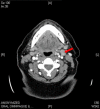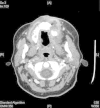Diagnostic and therapeutic challenges of EBV-positive mucocutaneous ulcer: a case report and systematic review of the literature
- PMID: 27127726
- PMCID: PMC4848873
- DOI: 10.1186/s40164-016-0042-5
Diagnostic and therapeutic challenges of EBV-positive mucocutaneous ulcer: a case report and systematic review of the literature
Abstract
Background: Epstein-Barr virus-positive mucocutaneous ulcer (EBVMCU) is a recently recognized B cell lymphoproliferative disorder that is driven by latent EBV infection and causes discrete ulcerations in the oropharynx, gastrointestinal tract, and skin. Local attenuation of immunosurveillance associated with iatrogenic immunosuppressant use, primary immunodeficiency, or age-associated immunosenescence has been implicated as a predisposing factor. This disorder is likely under reported, as it was only first defined in 2010 and shares histological features with other B-cell proliferative neoplasms. The first case series that described EBVMCU suggested that EBVMCU is generally self-limited and is likely to resolve without treatment. Since that publication, additional cases have been reported that describe a more heterogeneous clinical course, often requiring aggressive therapy. We now systematically review all published cases of EBVMCU and detail a case of aggressive and progressive EBVMCU, including diagnostic and management challenges, as well as successful treatment with radiation therapy.
Case presentation: A forty-nine year old woman presented with painful and debilitating multifocal oral EBVMCU that initially responded to four weekly doses of rituximab. Her disease relapsed within 3 months and continued to progress and cause significant morbidity. She was successfully treated with local external beam radiation therapy of 30 Gy in 15 fractions, with duration of response of at least 6 months.
Conclusions: We suggest that although many patients with EBVMCU experience a self-limited course, for others EBVMCU can be a debilitating, persistent disorder that requires aggressive therapy to prevent disease progression. CD20- and CD30-directed antibody therapy, local radiation therapy, local surgical excision, systemic chemotherapy, and a combination of these therapies have all been successfully used to treat EBVMCU with high rates of durable clinical remission. As EBVMCU is not currently included in the 2008 WHO classification of lymphoproliferative disorders and no evidence-based guidelines or expert opinions have been proposed to guide therapy, this case report and systematic review provides a foundation on which to guide therapeutic decisions.
Keywords: B-cell neoplasm; Epstein–Barr virus; Epstein–Barr virus-positive mucocutaeneous ulcer disease; Immunosenescence; Lymphoproliferative disorder; Radiation therapy; Rituximab.
Figures







References
Publication types
Grants and funding
LinkOut - more resources
Full Text Sources
Other Literature Sources
Research Materials

